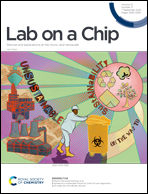Droplet microfluidics for functional temporal analysis and cell recovery on demand using microvalves: application in immunotherapies for cancer†
Abstract
Most common methods of cellular analysis employ the top-down approach (investigating proteomics or genomics directly), thereby destroying the cell, which does not allow the possibility of using the same cell to correlate genomics with functional assays. Herein we describe an approach for single-cell tools that serve as a bottom-up approach. Our technology allows functional phenotyping to be conducted by observing the cytotoxicity of cells and then probe the underlying biology. We have developed a droplet microfluidic device capable of trapping droplets in the array and releasing the droplet of interest selectively using microvalves. Each droplet in the array encapsulates natural killer cells (NK cells) and tumour cells for real-time monitoring of burst kinetics and spatial coordination during killing by single NK cells. Finally, we use the microvalve actuation to selectively release droplets with the desired functional phenotype such as for fast and serial killing of target tumour cells by NK cells. From this perspective, our device allows for investigating first interactions and real-time monitoring of kinetics and later cell recovery on demand for single-cell omic analysis such as single-cell RNA sequencing (scRNA), which to date, is primarily based on in-depth analyses of the entire transcriptome of a relatively low number of cells.



 Please wait while we load your content...
Please wait while we load your content...